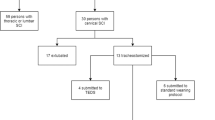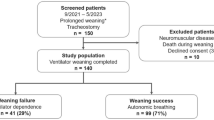Abstract
Study design:
Prospective, randomized, controlled parallel group trial with single-blinded data analysis.
Objectives:
To determine the safety and efficacy of higher (20 ml kg−1 ideal body weight (IBW)) vs standard (10 ml kg−1 IBW) tidal volumes (Vt) for patients with sub-acute traumatic tetraplegia during ventilator weaning using a 14-day (minimum) weaning protocol.
Setting:
United States regional spinal cord injury treatment center.
Methods:
Thirty-three ventilator requiring inpatients were randomized to either the higher (Group 1) or the standard (Group 2) Vt protocol. Initially, all patients were ventilated at 10 ml kg−1 IBW Vt and 5 cm H2O of PEEP for 72 h. For Group 1, Vt was raised 100 ml kg−1 until reaching target Vt of 20 ml kg−1 IBW. Group 2 was maintained at Vt of 10 ml kg−1 IBW. Plateau pressures were kept at or below 30 cm H2O. Safety outcomes included incidence of adverse events.
Results:
Because of smaller than expected enrollment, evaluation of efficacy was not possible. Therefore, we report the safety outcomes of 33 study participants. The 16 patients in Group 1 and 17 patients in Group 2 were demographically similar at baseline, except for age. The average age was 39.3 years in Group 1 and 27.2 years in Group 2, (P=0.002). There was no difference in median days to wean: 14.5 days in Group 1 and 14 days in Group 2. The incidence of adverse pulmonary events was similar between groups.
Conclusion:
Higher tidal volumes can be safely utilized during weaning of patients with tetraplegia from mechanical ventilation using a 14-day weaning protocol.
Similar content being viewed by others
Log in or create a free account to read this content
Gain free access to this article, as well as selected content from this journal and more on nature.com
or
References
National Spinal Cord Injury Statistical Center. Spinal Cord Injury Facts and Figures at a Glance. University of Alabama at Birmingham: Birmingham, Alabama. 2013.
DeVivo MJ, Krause JS, Lammertse DP . Recent trends in mortality and causes of death among persons with spinal cord injury. Arch Phys Med Rehabil 1999; 80: 1411–1419.
Watt JW, Wiredu E, Silva P, Meehan S . Survival after short- or long-term ventilation after acute spinal cord injury: a single-centre 25-year retrospective study. Spinal Cord 2011; 49: 404–410.
Charlifue S, Apple D, Burns SP, Chen D, Cuthbert JP, Donovan WH et al. Mechanical ventilation, health, and quality of life following spinal cord injury. Arch Phys Med Rehabil 2011; 92: 457–463.
Consortium for Spinal Cord Medicine. Clinical Practice Guideline: respiratory management following spinal cord injury: a clinical practice guideline for health-care professionals. Paralyzed Veterans Am 2005; 28: 259–293.
Lellouche F, Dionne S, Simard S, Bussieres J, Dagenais F . High tidal volumes in mechanically ventilated patients increase organ dysfunction after cardiac surgery. Anesthesiology 2012; 116: 1072–1082.
ARDS Network. Ventilation with lower tidal volumes as compared with traditional tidal volumes for acute lung injury and acute respiratory distress syndrome. N Engl J Med 2000; 342: 1301–1308.
Veeravagu A, Jiang B, Rincon F, Malenfort M, Ratliff JK . ARDS and ALI in patient with vertebral column fractures and SCI: a nationwide inpatient sample study. Spinal Cord 2013; 51: 461–465.
Wongsurakiat P, Pierson DJ, Rubenfeld GD . Changing pattern of ventilator settings in patients without acute lung injury: changes over 11 years in a single institution. Chest 2004; 126: 1281–1291.
Padman R, Alexander M, Thorogood C, Porth S . Respiratory management of pediatric patients with spinal cord injuries: retrospective review of the duPont experience. Neurorehab Neural Re 2003; 17: 32–36.
Peterson WP, Barbalata L, Brooks CA, Gerhart KA, Mellick DC, Whiteneck GG . The effect of tidal volumes on the time to wean persons with high tetraplegia from ventilators. Spinal Cord 1999; 37: 284–288.
Slutsky AS, Ranieri VM . Ventilator-Induced Lung Injury. N Engl J Med 2013; 369: 2126–2136.
Borg GA . Psychophysical bases of perceived exertion. Med Sci Sport Exer 1982; 14: 377–381.
Dodek P, Keenan S, Cook D, Heyland D, Jacka M, Hand L et al. Evidence-based clinical practice guideline for prevention of ventilator-associated pneumonia. Ann Int Med 2004; 141: 305–313.
Bernard GR, Artigas A, Brigham KL, Carlet J, Falke K, Hudson L et al. The American-European Consensus Conference on ARDS Definitions: mechanisms, relevant outcomes, and clinical trial coordination. Am J Respir Crit Care Med 1994; 149: 818–824.
Ranieri VM, Suter PM, Tortorella C, De Tullio R, Dayer JM, Brienza A et al. Effect of mechanical ventilation on inflammatory mediators in patients with acute respiratory distress syndrome: a randomized controlled trial. JAMA 1999; 282: 54–61.
Wong SL, Shem K, Crew J . Specialized respiratory management for acute cervical spinal cord injury: a restrospective analysis. Top Spinal Cord Inj Rehabil 2012; 18: 283–290.
Brown R, DiMarco AF, Hoit JD, Garshick E . Respiratory dysfunction and management in spinal cord injury. Respir Care 2006; 51: 853–870.
Manning HL, Shea SA, Schwartzstein RM, Lansing RW, Brown R, Banzett RB . Reduced tidal volume increases “air hunger” at fixed PCO2 in ventilated quadriplegics. Respir Physiol 1992; 90: 19–30.
Gutierrez CJ, Harrow J, Haines F . Using an evidenced-based protocol to guide rehabilitation and weaning of ventilator dependent cervical spinal cord injury patients. J Rehabil Res Dev 2003; 40: 99–110.
Acknowledgements
We thank the patients who volunteered to participate in this research. Gale Whiteneck, of the Craig Hospital Research Department participated in the conceptualization of the study design. Cate McGraw and Kelly Mowrey were actively involved in patient care and implementation of the research protocol. Matthew Fleishman, independently and blindly interpreted the chest radiographs. This research was supported by funding from the National Institute on Disability and Rehabilitation Research (NIDRR). The opinions here are those of the grantee and do not necessarily reflect those of the U.S. Department of Education, grant number H133N00006.
Author information
Authors and Affiliations
Corresponding author
Ethics declarations
Competing interests
The authors declare no conflict of interest.
Rights and permissions
About this article
Cite this article
Fenton, J., Warner, M., Lammertse, D. et al. A comparison of high vs standard tidal volumes in ventilator weaning for individuals with sub-acute spinal cord injuries: a site-specific randomized clinical trial. Spinal Cord 54, 234–238 (2016). https://doi.org/10.1038/sc.2015.145
Received:
Revised:
Accepted:
Published:
Issue date:
DOI: https://doi.org/10.1038/sc.2015.145



